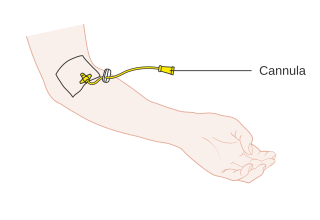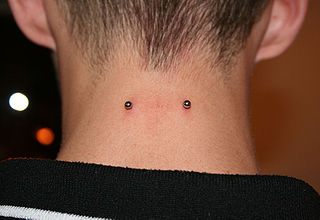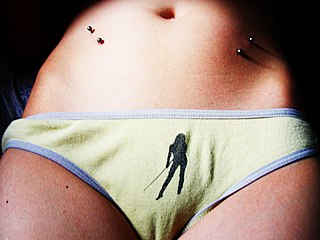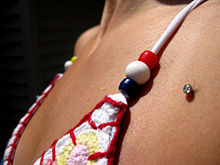
Plastic surgery is a surgical specialty involving the restoration, reconstruction, or alteration of the human body. It can be divided into two main categories: reconstructive surgery and cosmetic surgery. Reconstructive surgery includes craniofacial surgery, hand surgery, microsurgery, and the treatment of burns. While reconstructive surgery aims to reconstruct a part of the body or improve its functioning, cosmetic surgery aims to improve the appearance of it. A comprehensive definition of plastic surgery has never been established, because it has no distinct anatomical object and thus overlaps with practically all other surgical specialties. An essential feature of plastic surgery is that it involves the treatment of conditions that require or may require tissue relocation skills.

A cannula is a tube that can be inserted into the body, often for the delivery or removal of fluid or for the gathering of samples. In simple terms, a cannula can surround the inner or outer surfaces of a trocar needle thus extending the effective needle length by at least half the length of the original needle. Its size mainly ranges from 14 to 26 gauge. Different-sized cannula have different colours as coded.

Play piercing, needle play, or recreational acupuncture is body piercing done for the purpose of enjoying the experience rather than producing a permanent body decoration. Needles, sharpened bones, or other tools used in play piercing are removed from the body when the episode is complete, allowing the wounds to heal. Those who engage in play piercing may do so for self-expression, imitating tribal rituals, spiritual self-discovery, sexual pleasure, or entertainment.
In surgery, a percutaneous procedure is any medical procedure or method where access to inner organs or other tissue is done via needle-puncture of the skin, rather than by using an "open" approach where inner organs or tissue are exposed.

Pearling or genital beading is a form of body modification, the practice of permanently inserting small beads made of various materials beneath the skin of the genitals—of the labia, or of the shaft or foreskin of the penis. As well as being an aesthetic practice, this is usually intended to enhance the sexual pleasure of partners during vaginal or anal intercourse.

A subdermal implant is a body modification placed under the skin, allowing the body to heal over the implant and creating a raised design. Such implants fall under the broad category of body modification. Many subdermal implants are made out of silicone, either carved or mold injected. Many people who have subdermal implants use them in conjunction with other types of body modification to create a desired, dramatic effect. This process is also known as a 3-D implant, or pocketing.
In modern Western body piercing, a wide variety of materials are used. Some cannot be autoclaved, and others may induce allergic reactions, or harbour bacteria. Certain countries, such as those belonging to the EU, have legal regulations specifying which materials can be used in new piercings.
A transscrotal piercing is a body piercing that travels through the scrotum from front to back, or from side to side. It is a high risk procedure.
Scalpelling is a body art procedure similar to body piercing for the creation of decorative perforations through the skin and other body tissue, and is most commonly used as a replacement for or enhancement of ear piercing. Whereas piercing is typically performed with a hollow piercing needle or an ear piercing instrument, scalpelling is performed by using a scalpel to cut a slit into the skin. Unlike dermal punching, no flesh is removed. The technique can immediately produce holes with a larger diameter than can be achieved by piercing. This is a more rapid means of accommodating larger gauge jewellery than stretching, a technique whereby piercings are enlarged by inserting gradually larger jewellery. Scalpelling is performed to quickly achieve a large-gauge piercing, when scar tissue is preventing further stretching, if tissue has thinned to the point where further stretching could cause it to break, or to combine two closely placed piercings into one hole.
Stretching, in the context of body piercing, is the deliberate expansion of a healed piercing for the purpose of wearing certain types of jewelry. Ear piercings are the most commonly stretched piercings, with nasal septum piercings, tongue piercings and lip piercings/lip plates following close behind. While all piercings can be stretched to some degree, cartilage piercings are usually more difficult to stretch and more likely to form hypertrophic scars if stretched quickly. Dermal punching is generally the preferred method for accommodating larger jewelry in cartilage piercings.

A nape piercing is a piercing through the surface of the nape of the neck. Nape piercings are a type of surface piercing. They carry a high rate of rejection and migration, unless they are properly measured and placed. They may reject if they are not pierced properly, as they are in a part of the body that moves constantly and are easy to irritate, catching on clothing or other objects.
Lip augmentation is a cosmetic procedure that modifies the shape of the lips using fillers, such as collagen or implants. The procedure may be performed to increase lip size, correct asymmetry, create protrusion, or adjust the ratio of the top and bottom lips. The procedure typically involves surgical injection, though temporary non-surgical alternatives exist.

A corset piercing is a body piercing that consists of multiple piercings in rows, usually on the back, with ribbon or string laced through to mimic the appearance of a corset. Two rows of bilaterally symmetrical piercings are performed and can be composed of as few as four piercings or as many as the length of the area being pierced and the vertical space between piercings will allow space for. Due to the difficulty and risks associated with permanently healing single surface piercings, most corset piercings are intended to be temporary.

A hip piercing is a piercing in the pelvic area through the skin near the hip bone. Hip piercings are often done in couplets with one on each hip, but it is not unusual to see only one. Hips piercing are a type of surface piercing. Microdermals or skin divers can be implanted in the hip area to give a similar appearance.

In body modification, an implant is a device that is placed under the human skin for decorative purposes. Such implants may be subdermal or transdermal. In the context of body modification, some may consider injections of silicone and other substances a type of implant as well.

A surgical suture, also known as a stitch or stitches, is a medical device used to hold body tissues together and approximate wound edges after an injury or surgery. Application generally involves using a needle with an attached length of thread. There are numerous types of suture which differ by needle shape and size as well as thread material and characteristics. Selection of surgical suture should be determined by the characteristics and location of the wound or the specific body tissues being approximated.

Body piercing, which is a form of body modification, is the practice of puncturing or cutting a part of the human body, creating an opening in which jewelry may be worn, or where an implant could be inserted. The word piercing can refer to the act or practice of body piercing, or to an opening in the body created by this act or practice. It can also, by metonymy, refer to the resulting decoration, or to the decorative jewelry used. Piercing implants alter the body and/or skin profile and appearance. Although the history of body piercing is obscured by popular misinformation and by a lack of scholarly reference, ample evidence exists to document that it has been practiced in various forms by multiple sexes since ancient times throughout the world. Body piercing can be performed on people of all ages, although most minors are only permitted to have earlobe piercings.
Steve Haworth is a body modification artist based in Phoenix, Arizona. He is responsible for the invention and popularization of subdermal and transdermal implants, such as the "Metal Mohawk". He designed specialized medical instruments called dermal elevators for this process. He has also done pioneering work with surface bars, ear shaping, tongue splitting, magnetic implants, and artistic branding. He has worked on individuals noted for their extensive modifications such as The Enigma, Katzen, Stalking Cat, The Lizardman, and biohacker Tim Cannon. He is listed in the Guinness World Records as "Most Advanced Body Modification Artist", 1999 to present.
Alloplasty is a surgical procedure performed to substitute and repair defects within the body with the use of synthetic material. It can also be performed in order to bridge wounds. The process of undergoing alloplasty involves the construction of an alloplastic graft through the use of computed tomography (CT), rapid prototyping and "the use of computer-assisted virtual model surgery." Each alloplastic graft is individually constructed and customised according to the patient's defect to address their personal health issue. Alloplasty can be applied in the form of reconstructive surgery. An example where alloplasty is applied in reconstructive surgery is in aiding cranial defects. The insertion and fixation of alloplastic implants can also be applied in cosmetic enhancement and augmentation. Since the inception of alloplasty, it has been proposed that it could be a viable alternative to other forms of transplants. The biocompatibility and customisation of alloplastic implants and grafts provides a method that may be suitable for both minor and major medical cases that may have more limitations in surgical approach. Although there has been evidence that alloplasty is a viable method for repairing and substituting defects, there are disadvantages including suitability of patient bone quality and quantity for long term implant stability, possibility of rejection of the alloplastic implant, injuring surrounding nerves, cost of procedure and long recovery times. Complications can also occur from inadequate engineering of alloplastic implants and grafts, and poor implant fixation to bone. These include infection, inflammatory reactions, the fracture of alloplastic implants and prostheses, loosening of implants or reduced or complete loss of osseointegration.


















